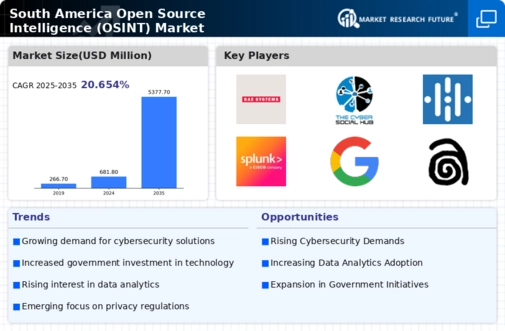Increasing Cybersecurity Threats
The rise in cybersecurity threats across South America has propelled the open source-intelligence market. Organizations are increasingly recognizing the need for robust intelligence solutions to preemptively identify and mitigate potential risks. In 2025, it is estimated that cybercrime costs could reach $10 trillion globally, with South America experiencing a notable share of this burden. As a result, businesses are investing in open source-intelligence tools to enhance their security posture. This trend is likely to continue as the sophistication of cyber threats evolves, necessitating advanced analytical capabilities to safeguard sensitive information. The open source-intelligence market is thus positioned to grow as companies seek to bolster their defenses against these escalating threats.
Emergence of Data Privacy Regulations
The introduction of stringent data privacy regulations in South America is influencing the open source-intelligence market. As businesses navigate the complexities of compliance, there is a heightened demand for open source-intelligence solutions that facilitate adherence to these regulations. By 2025, it is projected that the market for compliance-related intelligence tools will grow by approximately 20%. Organizations are increasingly seeking tools that not only provide insights but also ensure that data collection and analysis practices align with legal requirements. This trend underscores the importance of integrating compliance considerations into open source-intelligence strategies, thereby driving the market as companies strive to protect consumer data and maintain trust.
Growing Need for Competitive Intelligence
In the competitive landscape of South America, businesses are increasingly leveraging open source-intelligence solutions to gain insights into market trends and competitor activities. The open source-intelligence market is witnessing a surge in demand as companies strive to enhance their strategic positioning. By 2025, it is anticipated that the market for competitive intelligence tools will grow by approximately 15% annually. This growth is driven by the need for organizations to make informed decisions based on real-time data and analysis. As firms recognize the importance of staying ahead of competitors, the adoption of open source-intelligence tools is likely to become a standard practice, further propelling the market.
Rising Interest in Social Media Monitoring
The proliferation of social media platforms in South America has created a fertile ground for the open source-intelligence market. Organizations are increasingly utilizing open source-intelligence tools to monitor social media for brand reputation management, customer sentiment analysis, and Market Research Future. By 2025, it is estimated that social media analytics will account for over 30% of the total market for open source-intelligence solutions. This trend reflects a growing awareness of the value of social media data in shaping business strategies and enhancing customer engagement. As companies seek to harness the power of social media insights, the demand for open source-intelligence tools is expected to rise, driving growth in the market.
Government Initiatives for Digital Transformation
Governments in South America are increasingly prioritizing digital transformation initiatives, which significantly impact the open source-intelligence market. By 2025, it is projected that public sector investments in digital technologies will exceed $100 billion across the region. These initiatives often include the adoption of open source-intelligence tools to improve transparency, efficiency, and data-driven decision-making. As governments seek to enhance public services and citizen engagement, the demand for open source-intelligence solutions is likely to rise. This trend indicates a growing recognition of the value of open data and intelligence in fostering innovation and improving governance, thereby driving the open source-intelligence market forward.


















Leave a Comment